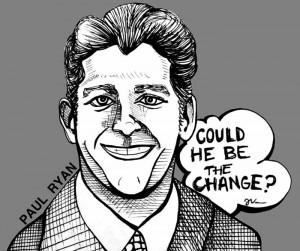New budget can mix the best of both worlds
In the last two weeks, we have seen one of the most positive developments to emerge from Washington, D.C. in a long time: Both Republicans and Democrats have released proposals for meaningful, long-term budget reform to get the federal government’s debt under control.
Each side has released its own partisan agenda, but combining the best ideas from both will ultimately best serve the interests of our country in the crucial years ahead.
In their willingness to at least address the government’s largest and fastest-growing costs, both parties’ plans promise to finally move the debate beyond the haggling over relatively insignificant amounts of discretionary spending that has dominated Capitol Hill for the last few months. It was obvious in the context of a deficit projected to reach $1.5 trillion this year that the difference between the Democrats’ desired $40 billion in spending cuts in the 2011 budget and the Republicans’ proposed $80 billion was barely worthy of debate.
The Republican plan, released last week by Rep. Paul Ryan (R-Wisc.), and the Democrats’, announced by President Barack Obama on Wednesday, represent the first time policy makers have moved beyond twiddling their thumbs on the most important domestic policy question of our time.
The plans, unsurprisingly, are starkly different from each other.
Ryan’s plan, titled “The Path to Prosperity: Restoring America’s Promise,” aims to cut $5.8 trillion in federal spending in the next 10 years.
Ryan proposes turning Medicare into a voucher program, whereby the government would contribute a specific amount of money toward seniors’ health plans.
He wants to shift the responsibility for Medicaid spending to the states and support them with block grants, which he claims would save the federal government $771 billion over the course of a decade.
Ryan also wants to cut $1.6 trillion in domestic discretionary spending by 2022.
Furthermore, in a proposal many are labeling his plan’s Achilles’ heel, Ryan wants to eliminate many tax breaks while also lowering the top marginal tax rate on both individuals and corporations from 35 percent to 25 percent.
Obama’s plan, in contrast, relies on a combination of spending cuts and tax increases to cut the deficit by a total of $4 trillion over 12 years. Aides say the plan would rely on $1 of tax increases for every $3 of savings from spending cuts, which Obama is selling as a more balanced approach to deficit reduction.
The president’s proposals include slowing growth in Medicare and Medicaid spending through a variety of measures, but without overhauling either system. Obama also wants to cut $400 billion from defense spending over the next 12 years and $600 billion from domestic discretionary spending over 10 years.
Obama was strongest on taxes, saying he, like Ryan, would eliminate loopholes — but also that he refuses to extend the Bush tax cuts again.
“There’s nothing serious about a plan that claims to reduce the deficit by spending a trillion dollars on tax cuts for millionaires and billionaires,” he said Wednesday at George Washington University.
Both plans have their strengths and weaknesses. Obama is right that tax raises and defense cuts — both inconceivable to the right wing — are unavoidable if the government is to make progress on the deficit.
The Republican’s refusal to even put those topics on the table is a denial of reality, but hopefully Obama’s forceful statements will make these issues a serious topic of conversation.
Obama’s vague proposals for reforming the major entitlement programs, however, are inadequate, which should play into Ryan’s hand nicely.
Ryan’s best suggestion is the transformation of Medicare. A voucher program would continue to support the elderly, while allowing market forces to bring health care costs down.
The rest of Ryan’s plan, however, smacks of partisan pandering.
Shifting Medicaid to the states would mean passing the burden of reform to even less fiscally responsible legislatures facing even more difficult budget problems — not a recipe for success. Meanwhile, cutting taxes for the wealthy as part of a deficit reduction proposal is absurd, and sure to reflect poorly on the rest of Ryan’s program.
Admittedly, even by combining the winning proposals of both sides and filtering out the weak ones, some key issues are left off the table altogether.
Especially disappointing is both parties’ lack of attention to Social Security, indicative of political caution at the beginning of an election cycle, but counterproductive policy-wise.
Still, that there are any proposals on the table, especially this early in the 2012 budget process, must be seen as a great achievement. With months left to negotiate, there is finally some reason for optimism the government might be able to start bringing the deficit down.
If a plan that incorporates each side’s best ideas — including tax raises on the wealthy, Medicare reform and defense cuts — is passed by next year, Ryan might indeed have helped us get back on “the path to prosperity.”
Daniel Charnoff is a senior majoring in international relations (global business). His column, “Through the Static,” runs Fridays.


Shouldn’t we first have discretionary income before having discretionary spending? We are borrowing $1,600,000,000,000 to have the Obama level of spending! OOops, subtract $38 billion from that number because of the budget deal.
If the spending for FY 2011 is more than FY 2010 then there is no “CUT”. There was no cut.
Our deficit spending exceeds the typical budget proposed by Bill Clinton during his first four years as president – now that is a big spender!